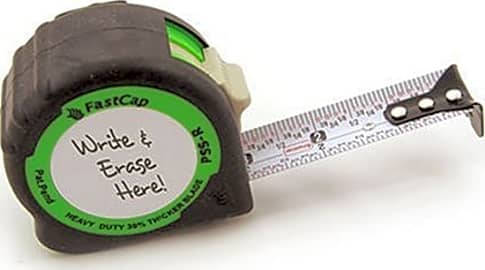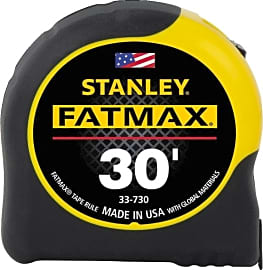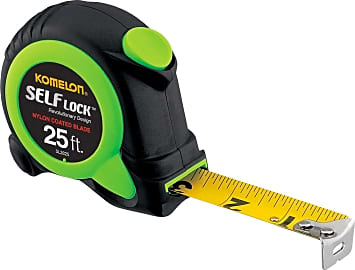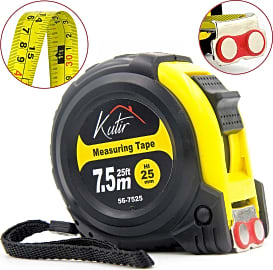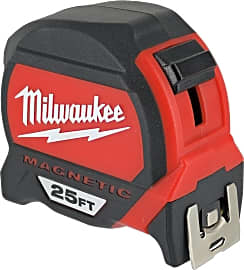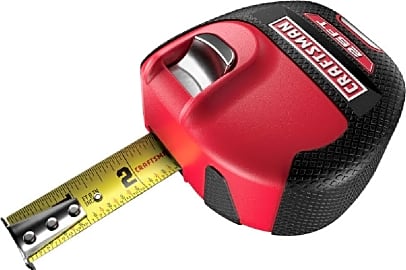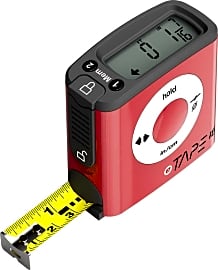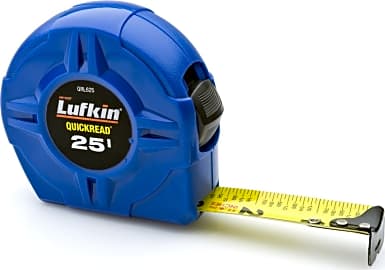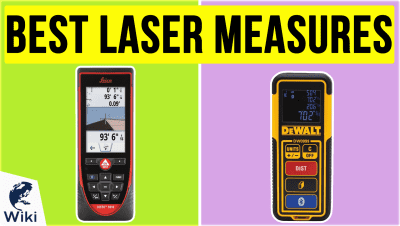The 10 Best Tape Measures

This wiki has been updated 37 times since it was first published in April of 2016. As the old saying goes, "Measure twice, cut once." Avoid unnecessary headaches and make sure all of your calculations are accurate with one of these tape measures. We've included the standard type you're already familiar with, along with more modern, electronic digital options, in a range of prices to suit both home DIY-ers and professional contractors who demand a high degree of durability. When users buy our independently chosen editorial selections, we may earn commissions to help fund the Wiki.
Editor's Notes
May 02, 2019:
Although just about every large tool company offers relatively durable tape measures, it remains tough to beat offerings from Stanley, including the Powerlock Tape Rule and the Fatmax. The Powerlock resembles the steel versions of yesteryear, but its chrome-colored plastic housing isn't as heavy — although still rugged. The Fatmax is even tougher, crafted from a blend of rubber and plastic, and perfectly able to keep up with the demands of a bustling job site. The FastCap Righty/Lefty is another strong choice, mainly because it can be read from either side. It is slightly less robust than the Stanley models, however, so consider it more for casual use. Home DIYers might also try the Lufkin Hi-Viz Quickread or the Komelon Self Lock, which aren't terribly expensive. As for digital options, the uniquely styled eTape 16 is one to consider, although it takes some learning and fiddling to use it with a high degree of precision. For this reason, many users prefer it for rough cuts or household tasks.
The Timeless, Ubiquitous Measuring Device
It frequently encounters grit, dirt, sawdust, and liquids, and it rubs at the point of entry every time it slides in or out.
Why do you think so many people still ride bicycles? They’ve been around for about 200 years. We ditched the horse-drawn carriage long ago, and we now have easy access to cars, scooters, trains, cabs, and Uber, none of which require us to exert much energy. Heck, I even saw a guy in a suit commuting to work on an electric skateboard earlier this week. So what gives?
I’ll tell you what: bicycles are simple, functional, and familiar. And there’s something rewarding about the physical nature of riding one.
Tape measures feel much the same way. Why try out some complex gadget when the item you have does a fine job as it is? Sure, you can parade around with a new-fangled laser measure, but if you’re someone who values practicality and efficiency, you can’t go wrong with this classic measuring tool.
Of course, the tape measure is only as effective as the person who uses it. Before you buy one, make sure you know how to correctly read measurements (yes, that includes fractions). If you plan to make highly detailed markings, you should also probably invest in a quality pencil with a fine tip. And keep in mind, when your work depends on precise measurements, what at first may appear to be a trivial mistake can end up ruining an entire job.
Speaking of the job — more specifically, the treatment of tools on a job site — tape measures tend to take a beating. They get tossed to the ground, covered in debris, and exposed to the elements. To combat this, make sure its case is robust, relatively thick, and resistant to corrosion. The same goes for the blade. It frequently encounters grit, dirt, sawdust, and liquids, and it rubs at the point of entry every time it slides in or out. A solid protective coating helps extend the life of the blade.
How To Choose The Right Tool
People often take tape measures for granted, but that doesn’t make them any less valuable. No matter the tradesman — carpenter, electrician, plumber — they use the tape measure as much as any device in their tool kit.
When selecting a tape measure, accuracy is obviously important, but you should focus on other qualities as well: size, style, the quality of the locking lever, and the design of the tang (the metal hook on the end of the tape). Be wary of models that are dolled up with extra, unnecessary features; with this tool, simplicity is king.
This flexibility allows you to retrieve measurements on round or cylindrical areas, as well.
In terms of accuracy, tape measures fall into one of four categories: Class I, Class II, Class III, and unclassified. Class I includes the most precise models on the market, while unclassified models are suitable for rough estimations at best. If you’re a nuclear engineer, go with a Class I tape measure, no questions asked; if you’re a woodworker, you’ll probably get by with a Class II or III.
Large, heavy tape measures can withstand bumps and bruises better than lightweight models, and their blades can usually extend farther without bending, as well. Conversely, more compact tape measures are easier to transport and handle, which makes them ideal for jobs that require agility and flexibility.
As with any tool, its design style will dictate how you utilize it. Hard tape measures, typically made with steel, are the most common and the most durable option. If you regularly measure long distances, this type is a no-brainer, as soft tape measures are designed to cover much shorter distances. Before you make a snap judgment, though, consider the drawbacks. Hard tape measures can basically only measure in a straight line, and the metal hook that clicks back in at high speeds poses a greater injury risk.
Not only do soft tape measures minimize the chance of injury, they’re ideal for measuring in hard-to-access areas, as they’re easy to bend and manipulate. This flexibility allows you to retrieve measurements on round or cylindrical areas, as well.
Your tape measure will either have a conventional blade lock (which requires manual lock engagement) or an auto lock (which doesn’t). Give both styles a shot, and try to find a model with the locking mechanism you prefer.
Most people assume the tang (or hook) is virtually the same for every tape measure, but that assumption is far from accurate. High-quality tangs should only hook onto objects you want them to hook onto. Multi-directional tangs allow you to hook items above, below, and to the side of your tape. Extremely large tangs are usually unwieldy and often catch where they shouldn't, and magnetic tangs frequently attract shavings, filings, and debris. You should avoid both if you don't need them.
A Brief History Of The Tape Measure
As you can imagine, people have been measuring things for centuries. The Ancient Romans, for example, marked strips of leather and used them as a sort of antiquated ruler. Somewhat surprisingly, the tape measure didn’t make an appearance in the United States until 1868, when a man named Alvin J. Fellows filed a patent for it in New Haven, Connecticut.
The Ancient Romans, for example, marked strips of leather and used them as a sort of antiquated ruler.
Because this crude tool was expensive (and rather ineffective), it never did come close to replacing wooden rulers. It did, however, serve as a model for today’s locking steel tape measures. In 1922, a man named Hiram H. Farrand received a patent for his version of the device, and with the help of The Brown Company, he began manufacturing and selling tape measures. Shortly thereafter, carpenters across the country began adopting Farrand’s design, which is quite similar to the models you find in the modern era.
Today, many tapes sold in the United States feature small black diamond markings every 19.2 inches to denote equal spacing for joists, which is a standard interval for studs in construction. This is unique to models designed in the United States. Historically, American tape measures have been created using only the imperial system, but that's slowly changing as manufacturers are increasingly incorporating the metric system into their designs.


